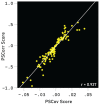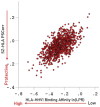Schizophrenia, Human Leukocyte Antigen (HLA), and Herpes Viruses: Immunogenetic Associations at the Population Level
- PMID: 37077512
- PMCID: PMC10108429
- DOI: 10.1177/26331055231166411
Schizophrenia, Human Leukocyte Antigen (HLA), and Herpes Viruses: Immunogenetic Associations at the Population Level
Abstract
Several factors have been implicated in schizophrenia (SZ), including human herpes viruses (HHV) and the adaptive immunity Human Leukocyte Antigen (HLA) genes. Here we investigated these issues in 2 complementary ways. In one analysis, we evaluated SZ-HLA and HHV-HLA associations at the level of a single allele by computing (a) a SZ-HLA protection/susceptibility (P/S) score based on the covariance between SZ and 127 HLA allele prevalences in 14 European countries, (b) estimating in silico HHV-HLA best binding affinities for the 9 HHV strains, and (c) evaluating the dependence of P/S score on HHV-HLA binding affinities. These analyses yielded (a) a set of 127 SZ-HLA P/S scores, varying by >200× (maximum/minimum), which could not be accounted for by chance, (b) a set of 127 alleles × 9 HHV best-estimated affinities, varying by >600×, and (c) a set of correlations between SZ-HLA P/S scores and HHV-HLA binding which indicated a prominent role of HHV1. In a subsequent analysis, we extended these findings to the individual person by taking into account the fact that every individual carries 12 HLA alleles and computed (a) the average SZ-HLA P/S scores of 12 randomly chosen alleles (2 per gene), an indicator of HLA-based SZ P/S for an individual, and (b) the average of the corresponding HHV estimated affinities for those alleles, an indicator of overall effectiveness of HHV-HLA binding. We found (a) that HLA protection for SZ was significantly more prominent than susceptibility, and (b) that protective SZ-HLA scores were associated with higher HHV-HLA binding affinities, indicating that HLA binding and subsequent elimination of several HHV strains may confer protection against schizophrenia.
Keywords: HHV1; Human leukocyte antigen; epidemiology; immunogenetics; schizophrenia.
© The Author(s) 2023.
Conflict of interest statement
The author(s) declared no potential conflicts of interest with respect to the research, authorship, and/or publication of this article.
Figures















Similar articles
-
Immunogenetic profiles of 9 human herpes virus envelope glycoproteins.Sci Rep. 2024 Sep 9;14(1):20924. doi: 10.1038/s41598-024-71558-1. Sci Rep. 2024. PMID: 39251790 Free PMC article.
-
In silico assessment of binding affinities of three dementia-protective Human Leukocyte Antigen (HLA) alleles to nine human herpes virus antigens.Curr Res Transl Med. 2020 Nov;68(4):211-216. doi: 10.1016/j.retram.2020.06.002. Epub 2020 Jul 2. Curr Res Transl Med. 2020. PMID: 32624427
-
Association of Dementia Human Leukocyte Antigen (HLA) Profile with Human Herpes Viruses 3 and 7: An in silico Investigation.J Immunol Sci. 2021;5(3):7-14. doi: 10.29245/2578-3009/2021/3.1218. J Immunol Sci. 2021. PMID: 40371217 Free PMC article.
-
HLA associations in schizophrenia: are we re-discovering the wheel?Am J Med Genet B Neuropsychiatr Genet. 2014 Jan;165B(1):19-27. doi: 10.1002/ajmg.b.32195. Epub 2013 Oct 19. Am J Med Genet B Neuropsychiatr Genet. 2014. PMID: 24142843 Review.
-
Genetics of the schizophrenias: a model accounting for their persistence and myriad phenotypes.Harv Rev Psychiatry. 2012 May-Jun;20(3):119-29. doi: 10.3109/10673229.2012.694321. Harv Rev Psychiatry. 2012. PMID: 22716503 Review.
Cited by
-
Unravelling the Viral Hypothesis of Schizophrenia: A Comprehensive Review of Mechanisms and Evidence.Int J Mol Sci. 2025 Aug 1;26(15):7429. doi: 10.3390/ijms26157429. Int J Mol Sci. 2025. PMID: 40806558 Free PMC article. Review.
-
Association between brain cancer immunogenetic profile and in silico immunogenicities of 11 viruses.Sci Rep. 2023 Dec 6;13(1):21528. doi: 10.1038/s41598-023-48843-6. Sci Rep. 2023. PMID: 38057480 Free PMC article.
-
Positive Association Between the Immunogenetic Human Leukocyte Antigen (HLA) Profiles of Multiple Sclerosis and Brain Cancer.Neurosci Insights. 2023 Dec 1;18:26331055231214543. doi: 10.1177/26331055231214543. eCollection 2023. Neurosci Insights. 2023. PMID: 38046672 Free PMC article.
-
Negative Association of Cognitive Performance With Blood Serum Neurotoxicity and Its Modulation by Human Herpes Virus 5 (HHV5) Seropositivity in Healthy Women.Neurosci Insights. 2024 May 31;19:26331055241258436. doi: 10.1177/26331055241258436. eCollection 2024. Neurosci Insights. 2024. PMID: 38827247 Free PMC article.
-
Viruses and psychiatric disorders: We have not crossed the borderline from hypothesis to proof yet (Review).Mol Med Rep. 2025 Mar;31(3):61. doi: 10.3892/mmr.2024.13426. Epub 2025 Jan 3. Mol Med Rep. 2025. PMID: 39749697 Free PMC article. Review.
References
-
- Sullivan PF, Kendler KS, Neale MC.Schizophrenia as a complex trait: evidence from a meta-analysis of twin studies. Arch Gen Psychiatry. 2003;60:1187-1192. - PubMed
LinkOut - more resources
Full Text Sources
Research Materials

